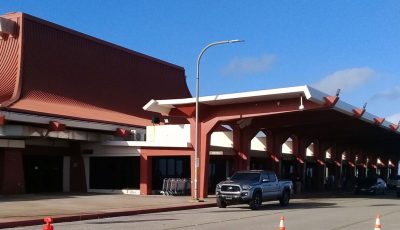IN TINIAN AIRPORT AIRSPACE RESTRICTION
FAA to study Navy request
CPA stands firm against proposal
The Federal Aviation Administration has informed the Commonwealth Ports Authority that it will look into the Secretary of the Navy’s request to restrict airspace on and around the Tinian International Airport.
In a letter to CPA board chair Kimberlyn King-Hinds dated Aug. 16, 2019, Angela R. McCullough, FAA Air Traffic Organization Mission Support Services vice president, said that FAA will conduct aeronautical and environmental feasibility assessments—given the project’s importance to national defense.
McCullough pointed out that the Secretary of the Navy’s letter does not automatically result in the approval of the airspace proposal but merely initiates the feasibility studies.
McCullough disclosed FAA’s action in response to King-Hinds’ letters to FAA and the U.S. Navy on June 21, 2019, making known CPA’s strong opposition to the Navy’s plan.
The U.S. Navy wants to include the airspace around the Tinian International Airport in the restrictive area of a divert landing strip it plans to build on the island.
King-Hinds told Saipan Tribune yesterday that FAA has been one of CPA’s strongest federal partner and has invested millions of dollars in the infrastructure in all three airports in the CNMI.
King-Hinds said she understands the FAA’s need to conduct the feasibility assessments when a request is made that invokes national security.
She said CPA is ready to participate in this process and to provide any information the FAA would need in doing the assessments.
In CPA’s letter to FAA, it raised serious concerns about the proposed restrictions and its impact on Tinian and the CNMI.
“We stand firm in our opposition and we will continue to raise our objections and advocate on behalf of the people of Tinian who have made it clear that restricting airspace on and around Tinian would adversely impact the wellbeing, health, economy, and safety of the community,” King-Hinds said in the letter to FAA.
McCullough told King-Hinds that the FAA met with Navy and Marine Corps representatives last May 23 to discuss the airspace proposal. McCullough assured that the safety of the national airspace “is our priority, and we endeavor to balance the needs of our airspace users and make for fair use of this finite resource.”
In making a final decision on the creation of a “special use airspace,” McCullough said the FAA must take into account aviation safety and environmental law compliance, optimum use of the airspace, and equitable access for all national airspace users.
Last July, the CPA board of directors unanimously passed a resolution opposing the U.S. Navy’s request. The directors agreed that the removal of airspace protections over the Tinian International Airport creates many issues that the Navy failed to discuss or consider with CPA prior to the Navy sending its request.
Navy Secretary Richard W. Spencer requested the FAA administrator last April 30 for unspecified but appropriate “relief” in the airspace protections over the Tinian airport.



























